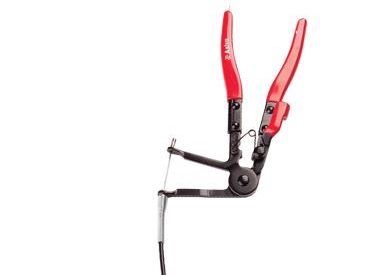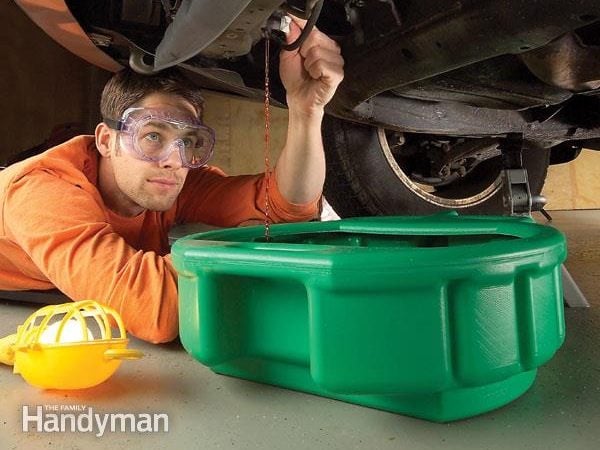
How to Change Coolant
In the old days (generally before 2000), changing your vehicle’s coolant was simple. After 2000, cars got more complex and many do-it-yourselfers got intimidated by the precise filling and “air-bleeding” procedures required to eliminate engine air pockets. But don’t worry, it’s easier than it looks. All it takes to get back in the game is a one-time $83 investment in an air-powered refilling tool. The details follow in the next slides.
Either way, you can change your coolant yourself in about an hour. But before you do anything, check your owner’s manual for the recommended procedures and coolant for your car.
Read on for awesome DIY car maintenance tips.
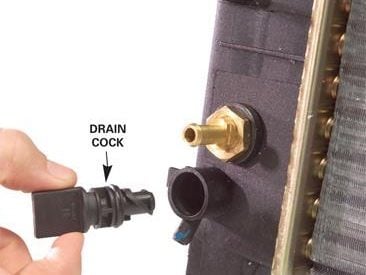
Open Drain Cock
Draining and Refilling Coolant in Older Cars
Open the drain cock by unscrewing, twisting a quarter turn, or twisting and pulling. (The various styles are shown in the next photo.)
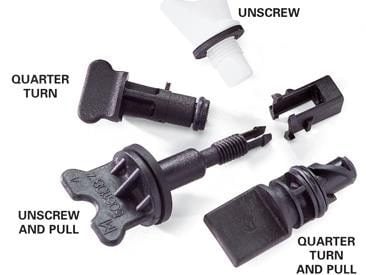
Drain Cocks
Drain cocks come in several different styles.
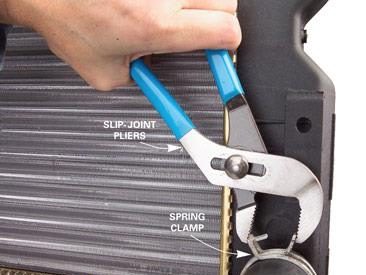
Remove the Hose
Push together the clamp spring with a slip-joint pliers and slip the clamp away from the neck. Pull the hose free and drain the remaining coolant. If access is difficult, a hose clamp pliers saves time and bruised knuckles.
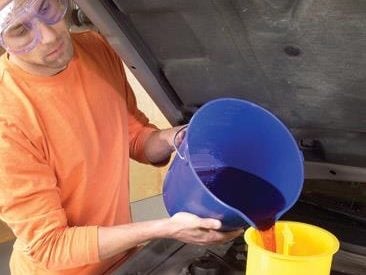
Add Coolant to the Radiator
Stir 1 gallon of full-strength (not pre-mixed) coolant and 1 gallon of distilled water together in a clean bucket before adding the mix to the radiator.
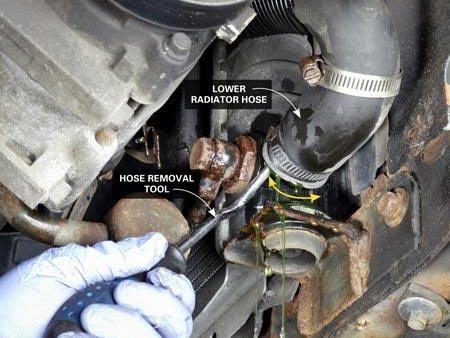
Remove the Lower Hose
Draining and Refilling Coolant in Newer Cars
Changing your coolant yourself, including buying the air-powered refill tool, will save about $50 on your very first coolant change, and about $100 on each one after that. This procedure works for any cooling system that’s not contaminated with rust or oil. We’ll show you how to check yours and then how to change the coolant.
Here’s what you’ll need:
• New coolant (2 gallons)
• Air-powered refill tool (about $85)
• Air compressor
• Hose removal tool (about $4 from auto parts store or online)
• Shop manual to locate block drain plugs
• Drain pan
• Absorbent paper towels
• Wrenches and screwdrivers
Start by checking the condition of your coolant when the engine is cool. Remove the radiator or coolant reservoir cap and examine the coolant color. If it looks rusty (don’t confuse orange coolant with rust), has crud or oil floating on the top, or looks like chocolate milk, call it quits and take it to a pro. You have problems that this procedure won’t solve.
If the coolant looks clean, start the job by jacking up the vehicle and supporting it with jack stands. Next, place a large drain pan under the radiator. Loosen the lower radiator hose clamp with pliers (springtype clamp) or screwdriver (worm-drive clamp) and remove the hose. If the hose won’t budge, use a hose removal tool to break it loose (see photo). Let the radiator and water pump drain completely. Then reattach the lower radiator hose and clamp.
Next, locate and remove the block drain plugs (they’re in a different spot on every engine, so refer to a repair manual for the location of yours). Reinstall the block drain plugs and move on to the refilling step.
Refilling with Fresh Coolant:
Insert the air tool into the radiator neck or overflow bottle. Connect the exhaust hose and compressed air line and route the open end of the tool’s exhaust hose into an empty gallon jug or pail. Then open the valve and let the vacuum rise until the needle reaches the edge of the red zone on the gauge. Then fill with coolant (see next slide). The vacuum sucks out any air pockets as it refills the system. When it’s full, just reinstall the radiator or overflow tank caps, remove the jack stands, and go for a spin.
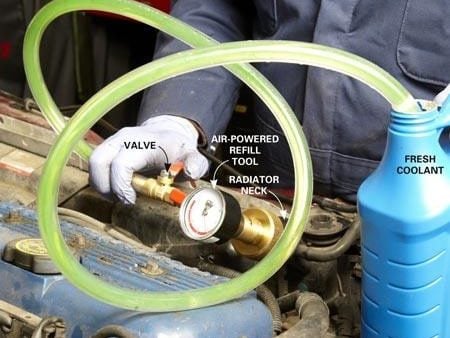
Vacuum-Fill the Cooling System
Jam the fill tube into the coolant bottle. Then open the valve and let the vacuum suck fresh coolant into the system. Repeat the procedure until the system is full.
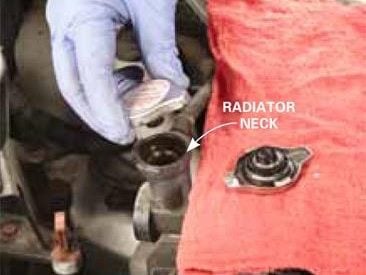
Replace the Thermostat and Radiator Cap When You Change the Coolant
The thermostat is the single most important component in your vehicle’s cooling system because it regulates engine temperature. Yet most owners don’t replace it when they change their coolant. That’s a mistake: A failed thermostat is the second most common cause of engine overheating and engine failure (a failed radiator fan is number one). And a worn radiator cap (sometimes it’s on the overflow tank) can also contribute to engine overheating. Both parts are inexpensive (about $12 each at any auto parts store) and are cheap insurance against overheating.
A radiator cap is a snap to change (see photo). It’s just a matter of unscrewing it and replacing it with a new one. Changing a thermostat yourself takes less than an hour (unless it’s buried). To find out how to replace yours, see How to Replace a Thermostat. But if yours is inaccessible, pay a shop to replace it.
Buying the Right Coolant
Most DIYers buy coolant at the auto parts store because the label says it’s “universal,” meaning it works in all cars. The carmakers disagree. Over the past several years, they’ve issued service bulletins warning that “universal” coolants are often incompatible with the newer metal alloys and gaskets and seals used in their vehicles. The carmakers aren’t saying that just to increase sales of their proprietary coolants. They’re seeing real (and expensive) damage caused by these coolants.
If you use the wrong coolant, you won’t see the damage for a few years. But when you do, it’ll cost you a bundle. So heed the manufacturer’s warnings and buy coolant right from the dealer. It’ll cost about $6 more per gallon (most vehicles only need 2 gallons), but the peace of mind is worth it.
Required Tools and Materials for This Project
• Air compressor
• Air hose
• Socket/ratchet set
• 4-in-1 screwdriver
• Adjustable wrench
• Rags
• Safety glasses
• Slip joint pliers
• Antifreeze
• Distilled water
• Drain cock
• Screw-cap plastic container for recycling coolant
• Paper towels
You’ll also need a trouble light, jack stands, a drain pan, a bucket, a funnel, disposable gloves and hose clamp pliers. For newer cars, you’ll need an air-powered refill tool.
Related links:
Fixing Up Your Own Car: Car Repair Tips from the Experts
7 Tricks to Try When Your Car Won’t Start
How to Change Your Car’s Transmission Fluid
